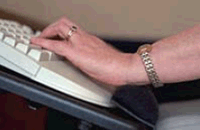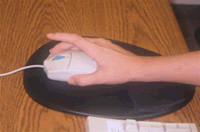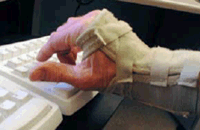|
Carpal Tunnel Syndrome
Carpal Tunnel Syndrome (CTS) is a disorder of the median nerve at the wrist. This nerve originates in the spinal cord of the neck, and travels down the arm to all the fingers except for the small finger (and adjacent half of the ring finger).
The median nerve has the least amount of room when it passes through the wrist (see figure). There are nine tendons that share the small tunnel with the median nerve. They are nearly surrounded by the carpal bones. The wrist is a wonderful piece of machinery until the tendons swell from overuse or abuse. Or, diabetes and smoking can impair the median nerve directly, just as they do throughout the body. Finally, obesity, low thyroid and other diseases can cause increased pressure in the carpal tunnel. Symptoms
When the median nerve is squeezed anywhere along its path, the individual experiences “pins and needles” in the affected fingers. In the early stages of CTS, these symptoms occur only at night, at least partially because many of us sleep with our wrist bent. As the disorder becomes more severe, symptoms occur during the day with awkward postures or excessive force, two main causes for the problem. Eventually, muscle strength is affected.
Risk Factors
Ergonomic risk factors increase the probability that one will develop carpal tunnel or other cumulative trauma disorder (also known as musculoskeletal disorders, or MSD’s). They are, in order of importance to carpal tunnel syndrome:
| Signs of trouble |
|

1. Awkward positions, especially keeping the wrist bent upward or downward.

2. Poor posture, which is closely related to the above, concerns body positions in general, including the spine. A good example is jutting the chin forward, which many of us do while at the computer or performing detail work. Another is reaching forward, which stretches and irritates the median nerve along its path from the neck to the fingers.
3. Excessive force, such as striking the keyboard too hard or maintaining a “death grip” on the mouse.

4. Sustained exertion, such as keeping your mousing index finger suspended in the air.
|
5. Repetition, doing any combination of the above over and over. Note that most people with correct keyboarding technique and posture are able to type very quickly all day without injury.

6. Contact pressure on the wrist, such as when the wrist is held on the edge of a desk. Even wrist pads can contribute to this risk factor.

7. Unfortunately, many people, some even on the advice of their physician, are using the wrong kind of brace, the so- called “cockup” type. This not only puts the wrist in a harmful position (awkward position), but it places pressure directly over the carpal tunnel (contact pressure). Using this while at the computer is a set up for disaster. Not only will it exacerbate CTS, but it frequently leads to elbow problems.
| |
| Self Care Remedies |
|
Good Posture
Sit upright and settle into the back of your chair. Scoot up to the desk and keyboard instead of reaching forward. Keep your head centered over your hips or even farther back. Your arms should hang down straight or somewhat forward of your shoulder joints and your elbows bent at 90 to 110 degrees. And most importantly, keep your wrist in the neutral position, which is straight and level.
Good Keyboarding and Mousing Technique
Use just enough pressure on the keys and mouse. Work relaxed and take sufficient breaks. The timing of your breaks depends on the type of work you do. If you are doing sustained data entry, you will need a few-second “micro-break” at least every hour, probably more often. Other workers have natural breaks in their work, which are helpful.
Stretching
Simply getting up from your chair will benefit you greatly. Walk around a bit. Stretch your neck, shoulders, wrists and lower back, spending particular time on areas that are stiff or sore. Do not cause pain – stretching should feel good. Speak to your physician if you have arthritis or other limiting condition. Refer to the Stretching Section of the Ergo Clinic Training or the Self Care Center for illustrations and instructions on specific stretches. Here are a few:

Braces
Look for specific carpal tunnel braces, which are helpful to wear at night. They keep the wrist straight, in the neutral position. The brace should generally NOT be used during the day, especially if you are working on the computer. |
 |
|

